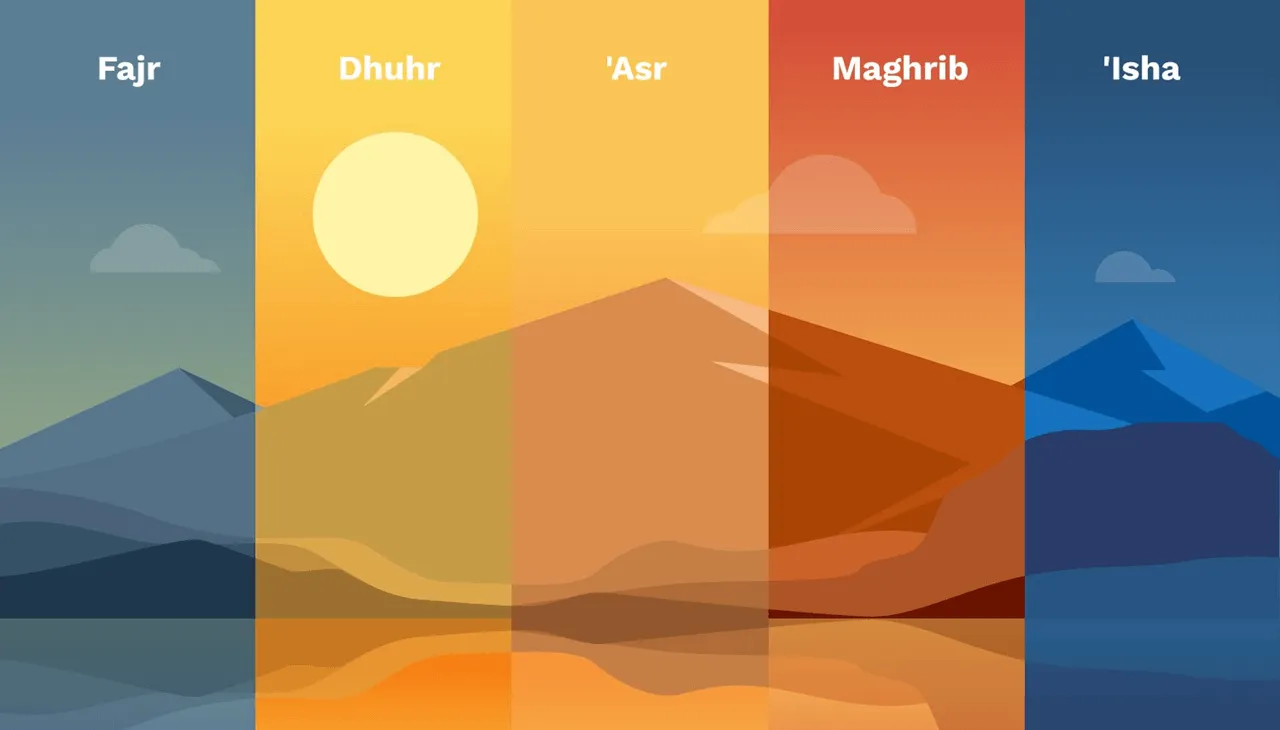Every day, at precisely five intervals, the muezzin sounds the public call to prayer (“adhan” or “azan”) from minarets or mosques. The angle at which the sun is positioned in the sky is used to calculate the prayer times. Since the Islamic day starts at sunset, Maghrib marks the beginning of the prayers, followed by Isha, which begins at nightfall.
The Fajr prayer, which begins at dawn, is the third of the five daily prayers and is timed according to the onset of twilight. Meanwhile, shadow lengths indicate the times for the Zuhr (midday) and Asr (afternoon) prayers.
Instruments and tables for calculating and displaying prayer times were developed by Islamic scholars who fused these practices with superior, more advanced astronomical and mathematical understanding.
Muslim Prayer Times
The daily summons to prayer (“adhan” or “azan”), are recited in Muslim communities to serve the purpose of reminding individuals to perform salat. The muezzin, who is responsible for calling worshippers to prayer inside of mosques, is the one who recites the adhan.
The muezzin calls worshipers to prayer by reciting the Takbir and Kalimah. Historically, the calls to prayer were made directly from the top of the mosque’s minaret without the use of amplification; however, many contemporary mosques employ the use of loudspeakers to ensure that all of the devout may hear the call.
The five mandatory (fard) prayers offered every day are performed at specific times dictated mostly by the position of the Sun in the sky. Therefore, salat timings differ around the globe. The ritual of wudu must precede any act of worship.
Please Note: Because an Islamic day begins at sunset, the Fajr prayer is technically the third prayer of the day. However, if one counts from midnight, it is traditionally the first prayer of the day. So, the order listed below is if we count the prayers from midnight:
Salat al-fajr – First Prayer of the Day
When the morning light fills the entire sky, known as “subh-e-saadiq”, the Muslim prayer time of fajr starts. This is a consensus held by all Islamic scholars.
The column of white light seen at dawn on the eastern horizon is really the first sign of daybreak (subh-e- kaadhib -false dawn). After a while, this brightness dissipates, and a second whiteness (lateral whiteness; second dawn) emerges from the eastern horizon
At this very moment, the Fajr begins, and the sky turns what is known as subh-e-sadiq (also known as real, second, or morning twilight).
- The “first dawn” is characterized by light radiating from east to west, whereas the “second dawn” illuminates the entire sky from north to south.
- A brief period of light, or “first dawn,” is followed by an extended period of darkness. Rather than descending into darkness after the “second dawn,” light levels rise.
- There is no intervening black space between the “second dawn” and the horizon, as there is with the “first dawn,” which is separated from the horizon.
Salat al-zuhr – Second Prayer of the Day
Once the sun has reached its zenith, or the highest point in the sky, and begun to move westward, Zuhr time has begun and it lasts until the call for the Asr prayer is given.
The best time to say this prayer is around lunch, as it falls in the center of the workday. On Fridays, the Zuhr prayer is substituted or preceded by the Friday prayer.
It is compulsory for all adult Muslim males who have reached the age of puberty and satisfy specific prerequisites and is to be performed in congregation at a mosque or with a group of Muslims.
Dhuhr, Duhr, Thuhr, and Luhar are all valid transliterations of this word.
Salat al-‘asr – Third Prayer of the Day
When Zhuhr finishes, we know it’s time for ‘Asr because that’s when the shadow of an object is exactly the same length as the object itself. The conclusion of ‘Asr occurs at two distinct periods.
- According to a hadith attributed to the Prophet (peace and blessings of Allah be upon him), “The time for ‘Asr lasts until the sun turns yellow,” the preferable time begins at the start of the time for ‘Asr and continues until the sun begins to turn yellow. Calculating this time depends on the season.
- Once the sun has set, the Asr prayer can no longer be performed, and it is not recommended (makrooh) to say the ‘Asr prayer after dark or when the sun is very low in the sky. The Prophet (peace and blessings of Allah be upon him) said: “Whoever catches up with one rak’ah of ‘Asr before the sun sets has caught up with ‘Asr.”
Salat al-maghrib – Fourth Prayer of the Day
The Maghrib prayer begins just after sunset, after Asr prayer, and continues till after nightfall, before Isha prayer. As soon as the sun goes down, at the conclusion of ‘Asr, the Maghrib period begins and lasts until the twilight or red afterglow has disappeared, around two hours later.
Maghrib concludes and ‘Isha’ begins once the scarlet twilight has faded from the sky. Calculating this time depends on the season. As soon as the crimson afterglow fades from the horizon, it is no longer Maghrib time.
This goes to show that as the day draws to a close, Muslims once again turn their thoughts to God in the final moments of daylight.
Salat al-‘isha – Fifth Prayer of the Day
When the red light in the west disappears, the Isha’a or isha prayer begins and continues until the “white light” (fajr sadiq) appears in the east. Before midnight, just between sunset and daybreak, is the ideal period for Isha.
After Shafaq (twilight) has settled in, the ‘Isha time period starts. This is a consensus held by all Islamic scholars. In the literature of hadith, the term shafaq is defined in two different ways.
Both Shafaqe Ahmar and Shafaqe Abyadh are common names for them. Each event follows the other, and together they create two distinctly visible brightness levels in the western sky. To put it simply, Shafaqe Ahmar comes before Shafaqe Abyadh.
Before going to sleep, Muslims once again reflect on God’s presence, guidance, mercy, and forgiveness.
Other Prayers and Their Times
Muslims, like followers of other faiths, are expected to follow certain rites and practices, excluding their daily prayers.
Eid-ul-Fitr Prayers
Muslims all throughout the world commemorate the conclusion of the month-long fasting of Ramadan on this day.
The Eid al-Fitr salat (Islamic prayer) is comprised of two rakats (units) and is often done in an open field or big auditorium. It is only permitted to be performed in a jamat (congregation).
The time to begin Eid-ul-Fitr prayers is 15 to 20 minutes after dawn, and you have till zawal, or around 10–15 minutes before the Dhuhr prayer, to pray it.
Eid-ul-Adha Prayers
This occasion celebrates Ibrahim’s (Abraham’s) desire to obey Allah by sacrificing his son Ismail (Ishmael). When Ibrahim was ready to sacrifice his son in the name of God, Allah substituted a lamb for him to slay.
Animals are sacrificed ceremonially as a way of remembering this intervention. The family that sacrifices the animal eats some of the meat themselves, and the remainder is given to the needy.
Similar to Eid-ul-Fitr, the time to begin Eid-ul-adha prayers is 15 to 20 minutes after dawn, and you have till zawal, or around 10–15 minutes before the Dhuhr prayer, to pray it.
Taraweeh Prayers
In the holy month of Ramadan, Muslims all around the world recite the nafilah salat known as Salat Qiyam Allayl. Prayer is said in congregation immediately following the Isha prayer. Usually, 20 rakaats are performed, with a little break occurring every four rakaats.
Salatul Janazah
Muslims in the area get together to pray for the dead. The Namaze Janaza is a common name for this invocation. Extra (four) takbirs are added to the prayer, but the ruku and sujud are not performed.
Every adult male Muslim is obligated to say the funeral prayer when a fellow Muslim dies, but when only a select few do so, it is no longer required of them all.
Muslim Prayer Times by City
| City | Fajr | Sunrise | Zuhr | ‘Asr | Maghrib | ‘Isha |
| Prayer Times Chicago | 05:26 AM | 07:05 AM | 11:43 AM | 02:38 PM | 04:20 PM | 06:00 PM |
| Prayer Times Minneapolis | 05:54 AM | 07:38 AM | 12:06 PM | 02:49 PM | 04:33 PM | 06:18 PM |
| Prayer Times Philadelphia | 05:34 AM | 07:09 AM | 11:53 AM | 02:55 PM | 04:36 PM | 06:13 PM |
| Prayer Times Houston | 05:41 AM | 07:05 AM | 12:15 PM | 03:46 PM | 05:23 PM | 06:48 PM |
| Prayer Times Boston | 05:21 AM | 07:00 AM | 11:37 AM | 02:30 PM | 04:12 PM | 05:53 PM |
| Prayer Times Brooklyn | 5:45 AM | 7:07 AM | 11:48 AM | 2:10 PM | 4:28 PM | 5:50 PM |
| Prayer Times Orlando | 05:42 AM | 07:05 AM | 12:17 PM | 03:52 PM | 05:29 PM | 06:52 PM |
| Prayer Times Dallas | 05:51 AM | 07:17 AM | 12:20 PM | 03:43 PM | 05:21 PM | 06:49 PM |
| Prayer Times Los Angeles | 05:18 AM | 06:46 AM | 11:45 AM | 03:06 PM | 04:44 PM | 06:13 PM |
| Prayer Times Irvine | 5:30 AM | 6:44 AM | 11:43 AM | 2:24 PM | 4:43 PM | 5:57 PM |
| Prayer Times Nashville | 5:30 AM | 6:46 AM | 11:39 AM | 2:14 PM | 4:32 PM | 5:49 PM |
| Prayer Times New York | 05:30 AM | 07:07 AM | 11:48 AM | 02:47 PM | 04:28 PM | 06:06 PM |
Conclusion
In the past, people just observed the sun to know when to pray at different times. These days, it’s common practice to have a written prayer schedule for the day that specifies the exact time that each prayer must begin. There are many such applications available.
When practicing Muslims neglect their prayers, they commit a grave sin. However, there are instances when it’s impossible to pray at the appointed hour. A Muslim is expected to recite the salat they missed as soon as feasible, if not as part of the following normal salat.


“When” and “how” the different prayer times comes around is clearly and graphically explained. Thank you. The “Why” are there 5 different prayer times should have been explained as background when the Rasul kept going back and forth to get Allah’s approval for a reduction from the original amount.
Prayer time for Uganda, spacefying the beginning and end of swallah
JazakAllah Khair for this detailed explanation of how prayer times are determined! It’s fascinating to see how astronomical calculations align with Islamic traditions, connecting worship to the natural rhythm of the day. For those looking for precise prayer timings globally, prayertimesksa.com offers accurate schedules tailored to your location. May Allah guide us all to observe our Salah at the prescribed times consistently!